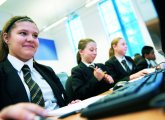We all know how key literacy is to people’s life chances; indeed, reading books is the only out-of-school activity for 16-year-olds demonstrably linked to securing managerial or professional jobs. A person with low literacy is more likely to live in a non-working household, experience overcrowded housing and have reduced work opportunities, and is less likely to vote. 10-16 year olds who read for pleasure do better at school – and yet, despite all this, according to a 2013 Mori poll, only 40% of England’s ten-year-olds have a positive attitude to reading.
A couple of years ago, with these statistics in mind, we launched our Warhorse inspired transition project at Harrow Way Community School, which begins every year when our incoming students at the end of Y6 have their induction day and are each gifted a copy of the Michael Morpurgo book, which we request that they read before the beginning of the new school term. We didn’t want these students to feel they were being given work – we just wanted them to read a story that we hoped they would enjoy; and if they were to have only have one book on their shelves at home, then we wanted it to be a great one!
We realised that some would have already read the book, some would want to and others might be reluctant or possibly struggle with the text. By making it clear that it was being given to everyone, and that many lessons at the start of Y7 would rely on having read the text, we were interested to see if this would inspire more widespread ‘buy in’ from students than a text does usually. It was important that we were promoting reading for pleasure, so no other tasks were linked to the book over the school holidays.
Interestingly, during the summer break of that first year I was approached on a number of occasions by parents in locations ranging from a busy train carriage to a chip shop queue, who said that their children were reading the book and would be ready for the new term. The response from both students and parents has been really positive and English staff, who study the text itself with Year 7, have not noticed large numbers who are struggling to explore the themes and characters of the novel as a result of not knowing it well.
Linked learning
As a tool to aid effective transition, we find the commonality of the Warhorse project, with all subjects teaching lessons linked around the one text, is a comforting nod to the primary system. Equally important though is the impact for disadvantaged students, in that everyone has the opportunity to start the term on an equal, level basis. Within this comforting environment, students also appreciate the increase in challenge saying, “It made it feel like it was a fresh start in a new school as the work was very different from primary school”.
From the very start of the autumn term all the curriculum departments deliver lessons inspired by or factually/thematically linked to Warhorse. It’s surprising how well the theme lends itself to each subject, even those you’d where you’d least expect a fit. For example, in science we’ve had students exploring the anatomy of horses, along with their adaptation to feeding and their digestive tracts. Converting the price of Joey from guineas to pounds and his height in hands into centimetres are typical questions in the Warhorse numeracy booklet resource which students particularly enjoyed. The maths department also have also brought the story up to modern times with an activity which saw students calculate the cost of taking a family of four to the theatre in London to see the play.
Naturally there are subjects where the brief proves a little easier to apply, with our students in art creating shadow puppets based on characters from the story, and large scale poppies incorporating scenes and emotions from the book. Dance lessons have looked at army training exercises, marching patterns and actions to represent battle and the feelings associated with returning home from war, and drama and music have collaborated to create a script for a radio play/ talking book complete with sound effects and songs of the period.
David Cade, our curriculum leader for Design and Technology was particularly pleased with the superb model a recent cohort created of the Somme battlefield from 1916.
“Working collaboratively and independently students designed and made all parts of the model using a range of materials (wood, plastic and textiles) and a variety of processes and techniques,” he says. “Having been submerged in Warhorse across the curriculum it seemed to give them a deeper, broader understanding of the conditions during the First World War which they applied to the task beautifully and sensitively.”
Positive progress
Has this approach been a success? Yes – absolutely. Our students are making good progress at Key Stage 3 and we believe this initiative, along with other projects and interventions, is raising the literacy standards in our school. We have seen good progress made by our last two cohorts of Year 7 and a great improvement in reading ages. Although other initiatives and procedures clearly contribute, there has been an improvement in the behaviour profile of these year groups. Our current Year 9s, who were the first to experience our Warhorse project, continue to make good or outstanding levels of progress in an environment of increased demand and preparing for final written examinations.
More importantly though is the feedback from students, who say that they enjoyed reading Warhorse (good pace and challenge) and they liked the fact they arrived at the beginning of term prepared for lessons which all had an increased relevance.
From a wider school perspective our headteacher, Michael Serridge, has seen the impact and influence the initiative is having on our students across the board. “The project was created to support the transition of students into secondary school and to promote literacy across the school from the very outset,” he comments. “Since starting Warhorse we have noticed that transition is indeed generally far smoother and we’ve engaged students from the off in literacy – it has been a wonderful success, with excellent feedback from students and staff”.
About the author
Graeme Fluellen is assistant headteacher at Harrow Way Community School, Andover.









